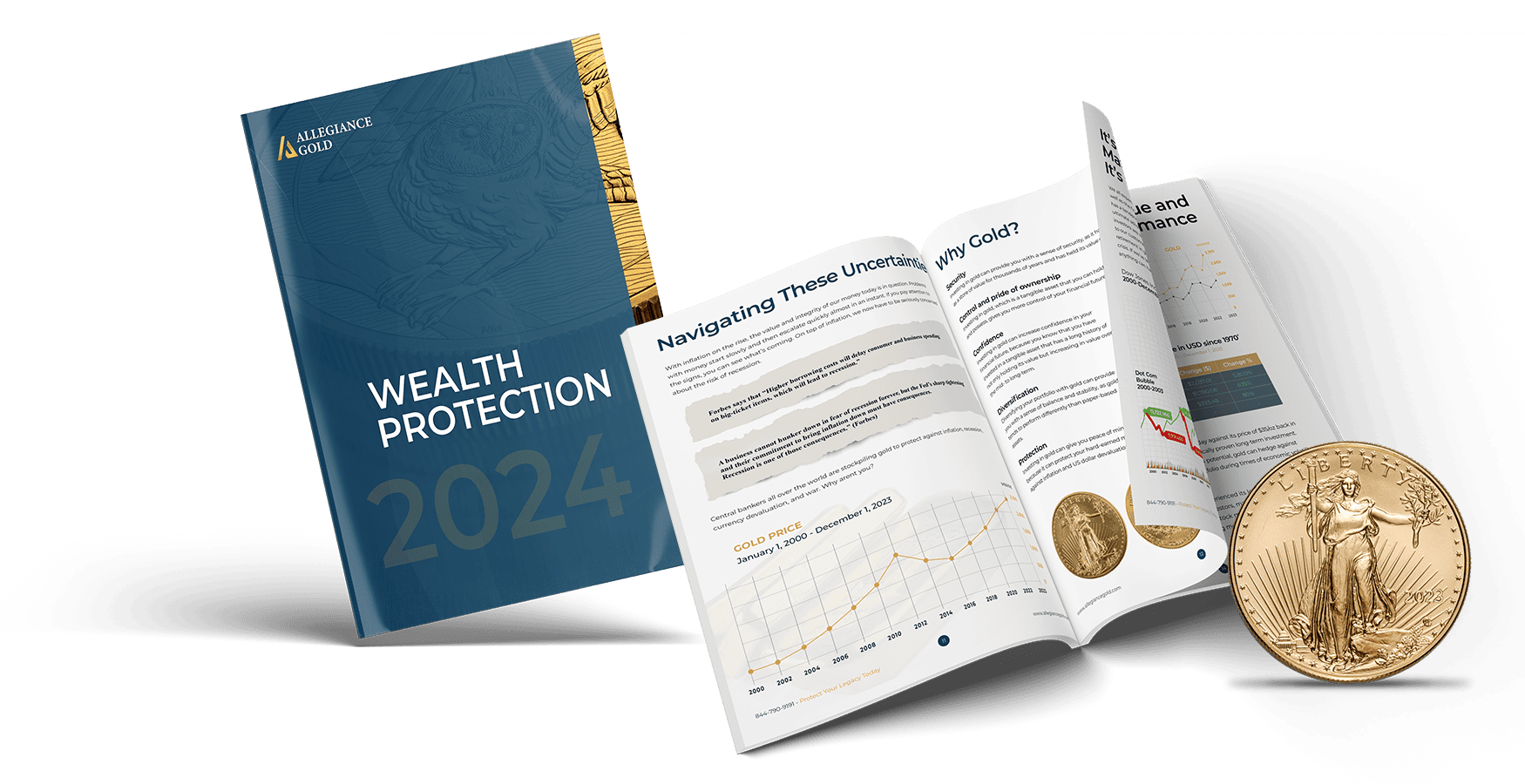If investing success can be measured by how much wealth can be amassed, the proper way to build and secure your assets would be to invest in the right assets to begin with.
Sometimes it’s hard enough deciding on the right investments but once you’ve made your investment decisions, you’ll want to stay on top of them to make sure that they continue to perform well for you. If you’re thinking you can simply “buy and hold” or “set it and forget it,” you may be setting yourself up to fail as neglecting to keep track of your investments can cost you dearly in the long run. Periodic reassessments and strategic investments in assets like gold or silver will not only preserve and grow your wealth but play a key role in your investment success.
How Gold Can Preserve Wealth
There are a number of ways gold and other precious metals like silver can help you preserve your wealth and secure your assets.
-
Gold is seen as a safe investment and ideal for portfolio diversification and wealth protection
-
Gold protects investor assets against inflation as it often balances out the market volatility
-
Physical gold investments are more advantageous than paper gold investments because you own a tangible product that won’t lose its value
When it comes to preserving wealth, there’s perhaps no other asset investors trust more than gold. Gold has a long track record of maintaining its value and purchasing power over the centuries, while hundreds of stocks, companies, and currencies have fallen by the wayside. That kind of resilience and permanence over a long period of time is attractive to investors, particularly those investing during times like these of devastating financial and economic uncertainty.
Benefits of Owning Gold
There are numerous investments benefits when it comes to gold but here are our top 4:
1. Wealth Stability and Appreciation
In a world where value and wealth are skewed by fiat paper currencies, it can be difficult to assess tangible wealth especially whether gaining and growing. Nominal values increasingly seem like we’re getting wealthier, but in actuality, prices of goods are just getting higher.
Gold, on the other hand, not only maintains its purchasing power over time but has grown leaps and bounds. Gold has grown 500% in the last 20 years. If you compare that to the dollar value and purchasing power, you can see the significant growth gold is making and continues to rise. In fact, its annual rate of growth in the last 50 years has exceeded that of the Dow Jones Industrial Average and the S&P 500.
Gold has recently broken the $2,000 barrier, and there’s no telling how far it will continue to climb. The dollar, on the other hand, continues to lose its value.
2. Portfolio Hedging and Diversification
Portfolio diversification means not putting all of your eggs in one basket. In order to minimize risk, your best bet is to invest in multiple asset classes, asset types, and geographic areas. That not only lowers the risk profile of your investments but ensures that in the event of a collapse in one sector of the economy, you’re not losing all of your money.
Gold can play a key role in diversifying your investment portfolio, as its risk profile is lower than stocks or bonds. Even the most fervent supporters of stock investing will often agree that gold should play a role in portfolio diversification. All the banks invest in gold for that reason, not to mention the wealthy elite. Most recently Warren Buffett exited banks in favor of gold putting $565Mil into the precious metal. Much high profile and everyday investors are following suit.
3. Retirement Protection and Growth
American workers and retirees hold trillions of dollars of assets in retirement accounts such as 401(k)s and IRAs. While these accounts can certainly do wonders in growing wealth during good times, during economic hardships they can be less than ideal during tough economic times, due to the fact that investment options through these accounts can be quite limited.
That’s precisely why more and more investors are beginning to roll over their existing retirement account assets into new retirement accounts. Among the options they have is investing in a gold IRA. By rolling over existing retirement savings into a gold IRA, it’s easy to maintain the same tax advantages as your current retirement accounts, while gaining the ability to benefit from the protection that gold offers. A rollover from a 401(k), TSP, IRA, or similar account can be done with relative ease and can go a long way toward protecting your retirement savings.
4. Performance Against Inflation
We’ve come to see over that the Fed will do everything it can to boost inflation. If you thought $3 trillion in money creation in a matter of weeks was crazy, just imagine what will happen when the Fed really gets going.
With so much money being created out of thin air, the US dollar will continue to weaken and devalue in the future, and it will be more important than ever for investors to protect themselves against that inflation. Many still remember when you could put money in a bank savings account and receive a decent amount of interest. But interest on savings accounts never exceeded inflation rates over the long term, making savings accounts a wealth-waste.
While there are no guarantees that any asset will always make gains, when looking at the past 50 years of asset prices, gold is one of a handful that has consistently made real returns. With stock markets widely expected to flounder over the next decade, gold may be one of the best bets for investors looking to protect their assets against inflation in the coming years.
How Much Gold Should Your Portfolio Have?
Since Gold is a popular way of diversifying and hedging your portfolio, the next question is naturally how much gold should you have in your portfolio. The amount of gold in your portfolio varies with how you’re looking to balance the risk factor of market volatility Some may choose to have as little as 10-15% to feel safe while others feel more comfortable with 50% knowing they are better protected against an economic crash.
Whatever percentage you decide on, the key is that you want to make sure that your gold investment is helping you achieve your investment goals. Fortunately, with gold, whether physically in your hand or in your IRA, it’s easy to liquidate if you need it in a pinch or increase when you see the value rising and you want to get ahead of its gains.
What Is the Best Time to Invest in Gold?
With the track record gold has had in just the last 50 years, it’s an obvious investment for anyone looking to properly diversify their portfolio, not only to protect their savings but see actual gains. In the past 20 years alone, gold has climbed up 600%, and even since the last crash of 2008, it has grown 250% and mostly in the 3 years following the crash. The truth s, when there’s this kind of financial/economic/political instability, it becomes the perfect backdrop for seeing significant returns for commodities, especially precious metals.
If you’ve been thinking about investing in gold, there has never been a better time than right now. That’s especially true if you’re interested in doing a 401(k) to gold IRA rollover. With stock prices still high, investors can cash out of their stock investments and cement the gains they’ve been accruing over the past several years. By rolling over their retirement accounts into gold, they can position themselves to take advantage of what could be a multi-year bull market for gold.
Protect Your Investments With a Gold IRA
The easiest and simplest way to invest in gold is with a gold IRA. Don’t get complacent and think you have plenty of time to roll over your assets into gold. In the past 6 months alone, gold climbed nearly 30% and showing no signs of stopping. That could have been an extra 30% for your retirement. With gold still expected to double in years to come, it makes for the ideal low risk, high return investment.



 Custom Precious Metals IRA
Custom Precious Metals IRA Gold IRA
Gold IRA Gold Products
Gold Products Silver Products
Silver Products Platinum
Platinum